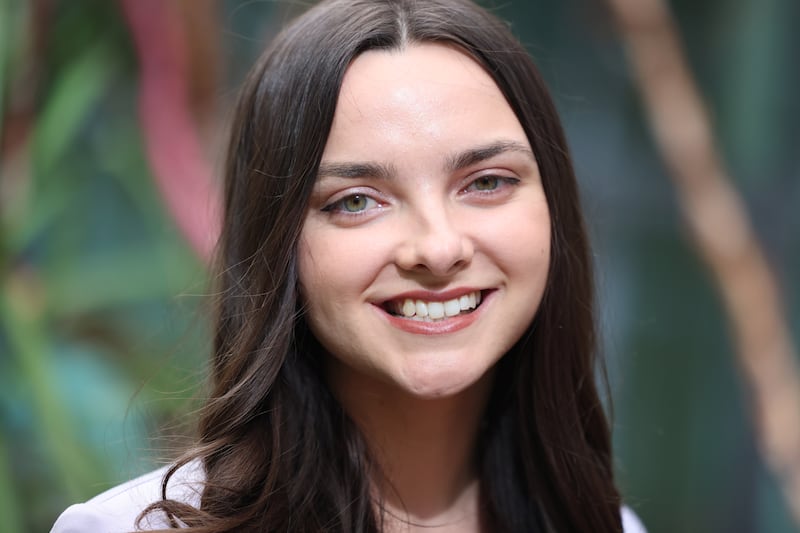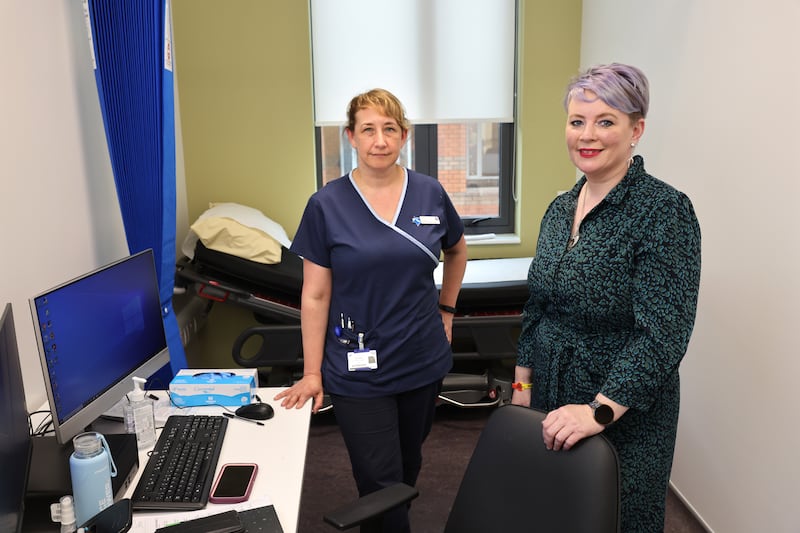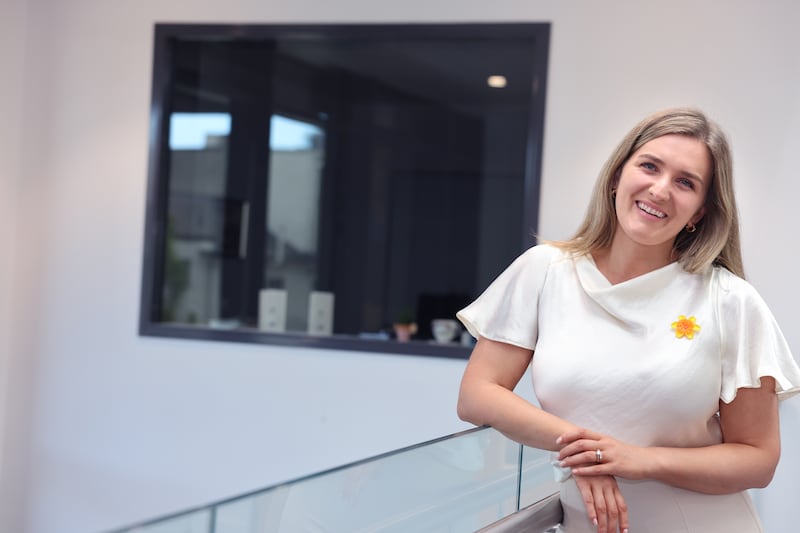In the summer of 2019, 21-year-old Stacey Braddish began to feel unwell. Interrailing across Europe with friends, she put down breathlessness and a fast-beating heart to the chaos of a college summer holiday. What else would it be?
Back in Ireland, the symptoms persisted amid the trials of her fourth year at university and soon, she booked a doctor’s appointment, expecting, perhaps, an asthma diagnosis.
“They ended up finding a 10cm tumour in my chest,” she said and she was soon diagnosed with stage two Hodgkin’s Lymphoma, a type of blood cancer. “At the time, I didn’t really fully process it. It was just such a shock. You don’t think anything’s ever going to happen to you when you’re that age – especially not something that serious.”
A week later she started chemotherapy and people assumed it was her mother – rather than herself – attending for treatment.
READ MORE
“It’s quite hard when you’re younger, when you’re in the treatment centre surrounded by people maybe three or four times your age. You end up getting stared at because you don’t really fit in,” she said.

The side effects of the drugs frequently left her bed ridden with nausea, hair loss, lack of appetite, weight loss and, later, weight gain. After four months, the chemotherapy stopped working so doctors increased the strength of the drugs, until those, too, failed to have an effect. Radiotherapy was a last-ditch effort to save her from the cancer, which left her as an inpatient at St James’s Hospital in Dublin surrounded by those much older and, at times, doing quite poorly.
If you think about it: you’re 22, you’re final year in college and then, all of a sudden, you’ve got to move back in with your parents, you’re relying on them potentially for toileting
— Dr Scheryll Alke
“It just felt like I never met anyone that was like me,” she said. “I just felt completely alone at that time.”
Of the 44,000 people diagnosed with cancer in Ireland each year, Stacey is part of a relatively small and traditionally overlooked group of about 180 adolescents and young adults (sometimes known as AYAs in medical circles) diagnosed with cancer each year. At the time, her treatment was bundled in with adults old and young – but things are changing, slowly.
Among cancer patients aged 16-24 in Ireland, survival rates are relatively high at 85 per cent across the board but, unlike other age groups which have seen rates improve over the years, many young people’s cancers have seen success rates improve modestly, not at all or decreased.
“The tumour types [in adolescent and young adult patients] are very distinct compared to what happens when people get older,” said Dr Scheryll Alken, consultant in adolescent and young adult cancer at Children’s Health Ireland, Crumlin, and St James’s Hospital. “The difficulty with AYA groups is that they don’t quite fit into the program for paediatrics because a 16-year-old is not the same as a 10-year-old and they’re not quite served by a programme that’s designed to look after cancers in older patients.”
[ Nurses in 26 cancer treatment centres proving a valuable resourceOpens in new window ]
In recent years, there has been a greater recognition in Ireland of the specific needs of this group, not just physically but mentally too.
“They need adjusted treatments that are specifically focused for them,” she said. “The point of adolescence is to get away from your parents, to build your own sense of identity, to independently move out into the world. If you think about it: you’re 22, you’re final year in college and then, all of a sudden, you’ve got to move back in with your parents, you’re relying on them potentially for toileting. It’s a massive retrograde step, which can take people a long time to recover from.”
As a group with a long time to live after beating the disease, cancer treatments can have pronounced long-term impacts such as fatigue, issues with hearing, fertility, bone health, concentration, cognition and an accelerated ageing process.
“We want to not just think about curing the cancer but we want to think about maximising their life the whole way through.”
Last year, St James’s Hospital in Dublin was one of three nominated as adolescent and young adult cancer units (including Cork University Hospital and Galway University Hospital), aiming to meet the unique needs of young people medically and psychologically.
Consultant haematologist and team lead at the adolescent and young adult unit at St James’s Hospital, Prof Larry Bacon, said that, until now, young people have “certainly had unmet needs. Cancer UK have been providing adolescent services for quite a while – five or six years now – so, we’re a little bit behind them.”
So far, the changes have been “an ideological change” among staff, some new hires – including a clinical nurse specialist in the area – and four new private rooms have been modernised for adolescent and young adult patients with mood lighting, smart TVs, better internet and a young person’s “den” for socialising in is in the works.
Once a month, St James’s also runs a non-medical “hang out” at the Guinness Enterprise Centre near the hospital, where young people with cancer or have recovered get the chance to meet others, share tips about living with cancer and the life thereafter. “To give them back their sense of self,” Dr Alken said.
They don’t yet have a bed for every adolescent and young adult patient but the wider framework for the care of such patients is aimed to be completed between 2025 and 2028.
‘The only cancer kid’
Hooked up to machines and surrounded by doctors can prove rather isolating and dull. Brightening up the halls of St James’ are people like Brenda Conboy, a 71-year-old cancer survivor and an Irish Cancer Society volunteer at the hospital. A beaming presence in the room, her wisdom is a testament to the life that goes on after cancer.
“I’ve had cancer myself years ago so it’s just giving a bit back,” she says. “You just talk to the patients, give them advice if they need it, emotional help or practical help.
“I would sit with somebody if they need me for an hour or so to make sure they’re not frightened, to make sure there’s hope. Because I’ve been through it myself, I think it’s kind of reassuring to see me jumping around the place and not a bother on me. As I always say to the patients: ‘Every step you take, we take with you.’ And that’s all they want.”
Bridging the social gap in the health system for these young people is CanTeen Ireland (Cancer in Teenagers), which primarily helps its members with weekends away to adventure centres, online social events, drama and exercise programmes.
[ ‘The way I see it, my new bra is half full, not half empty’Opens in new window ]
“People do think I actually work in a canteen,” laughs Evelyn Griffith, manager at the Irish Cancer Society-funded organisation. “If you’ve seen the Fault In Our Stars [a 2014 film based on John Green’s 2012 novel of the same name], some people think we just sit around with bald heads and talk about cancer but we don’t!” Not all the time, anyway.
“It’s so isolating in the hospital,” she said. “You’re away from your friends and [they] don’t really understand what you’re going through. So, that’s why it’s important to meet others like them and not be the only cancer kid. They’re just getting such a battering psychologically, physically, emotionally that it is so important they can be themselves and not be the sick person. Parents would say to me, ‘The minute they came away that first weekend, it was like a different person came home’, which is amazing.”
Many of CanTeen’s 25 or so volunteers are cancer survivors, living fruitful lives with families of their own, giving hope to those struggling with the disease.
“We lose people, unfortunately,” she said, adding they hold memorials to talk about their friends who have died. “They live right until they die. I’ve known young people who were very much doing everything they could right up until the last minute. So, they teach a lot about living in the moment and enjoying life when you can.”

Sniper fire
Leading the charge on this national shift towards a holistic care of adolescent and young adult patients is Prof Owen Smith, Oncology Professor at Trinity College Dublin. In 2019, he was appointed the national clinical lead in implementing the recommendations of the latest national cancer strategy by the National Cancer Control Programme (NCCP).
“These are the people we used to call the people from Middle Earth – the hobbits, the people that fell in between stools,” he said. “And it’s not just in cancer but right across the board in chronic diseases.”
The first and second cancer strategies in 1996 and 2006 made no mention of the unique needs of adolescents and young adult patients, while the new strategy aims to prioritise “age-appropriate facilities”. The new children’s hospital will increase the in-patient capacity by 50 per cent, from 19 in Crumlin to 28, with an extra six beds dedicated to adolescents and young adults.
For Smith, the key to improving survival rates is increased usage of clinical trials – something previously neglected.
“We have this anomaly in Europe and North America where entry criteria stops around 18. We know biology doesn’t work like that. We’ve been pushing hard through the European Commission to start changing that approach because we know when a patient is entered into clinical trials, cure rates tend to be better. The commonest cancer in under 20-year-olds is acute lymphoblastic leukaemia and the outcome on clinical trials is now approximately 90 per cent.”
In Children’s Health Ireland at Crumlin, about 65 per cent of children up to age 16 with cancer go on to trials, compared to just 3 per cent of adults, with the remainder often not availing of trials as they aren’t always open for participants.
Once a patient is on a clinical trial, scientists are more likely to get the chance to study the molecular basis of what is driving tumour formation in that patient, Prof Smith said.
It can feel really overwhelming when you finish [treatment]. Even though everyone else thinks that you’re fine and expects you to go back to life as it was, you can’t
— Stacey Braddish
“We know far more about the biology of a lung cancer in a 75-year-old than we do about a lymphoma in a 22-year-old. So, when you’re on a clinical trial, it is more likely that we get to know more about the biology. Instead of using these drugs like carpet bombing, now, we need to be going for a more targeted therapeutic approach – sniper fire. So, once we unravel the biology of these tumours, usually through a clinical trial setting, then we can go more targeted.”
That “carpet bombing” approach is part of the problems that persist in cancer survivors in later life. For a childhood survivor 50 years after treatment, they will have developed, on average, 17 chronic conditions. Targeted “sniper fire” makes a massive difference to young people.
Dr Naomi Algeo, a senior occupational therapist at St James’s Hospital and Trinity College Dublin, is researching how to enhance the quality of life for adolescents and young adults after cancer.
“I think a lot of people think, ‘Oh, the cancer is gone. The treatment is finished. Get back on with your life.’ But, actually, it’s not over yet and it’s those invisible things that you can’t see, such as the fatigue, brainfog, pain, anxiety,” she said. “There’s a lack of understanding there, in general, about what anyone living beyond cancer is experiencing after their treatment.
“AYAs are more likely to be disadvantaged in terms of doing better academically than their peers and that’s going to have a knock-on effect later in life in terms of employment.
“The medical teams are obviously saving lives – we’re hoping to enhance lives. Traditionally, the focus was always on curing cancer and that’s still a really important focus but there has been a paradigm shift in recent years towards cancer survivorship and living beyond cancer.”

Fertility
Despite fertility problems being a common issue with cancer survivors, Ireland ranks the fourth lowest in Europe at preserving sperm and eggs with just 27 per cent of adolescent and young adult patients availing of the service.
“I think when a young person knows their survival is low, having something that is a potential hope for the future can be really helpful,” said Dr Alken. “That means you have to be a teenage [boy] who is old enough to masturbate into a cup, when you’re sick, under high stress and your parents are standing outside the room. It’s incredibly stressful but it’s the one thing we know in 10 or 15-years’ time, people regret not having done it.”
The Irish Cancer Society has provided €420,000 for adolescent and young adults to work with the Merrion Fertility Clinic in Dublin on preserving their sperm and eggs, which most adolescents and young adults can avail of, but the funding will soon run out. Legislation to have this process Government-funded is working its way through the Oireachtas.
[ Tánaiste hails improvements in cancer care since Belfast AgreementOpens in new window ]
“We are well behind in this particular area.” Prof Smith said. “Other areas we are way ahead but this is an area that has been, I would suggest, neglected in the past. You’re going to take an adolescent or young adult, bring them to the edge and give them this nasty chemotherapy but not a parachute for their future? I don’t want to point fingers but [legislatively], we haven’t really grasped the nettle here. In other countries, it’s much smoother but we’re going to get there in the next two years.”
For Stacey, now 25 years old, her life is back on track after her seven-month encounter with cancer. All her friends with cancer have since recovered; she self-published a cancer planner that helped her keep track of her treatment, symptoms and feelings; she sits on the NCCP’s Young Person’s Advisory Group (YPAG), sharing her views on how to improve services; and she’s working as a cardiac physiologist in Connolly Hospital Blanchardstown. She is optimistic about the future of cancer care in Ireland.
“It can feel really overwhelming when you finish [treatment] and you just feel everything has changed,” she said. “Even though everyone else thinks that you’re fine and expects you to go back to life as it was, you can’t.”
For years after getting the all-clear, her heart was beating fast, she couldn’t exercise (“like an old woman in a young body” is how she described it) and felt anxious over a return of the cancer – a fear she’s come to terms with now.

















